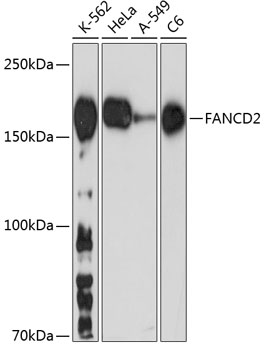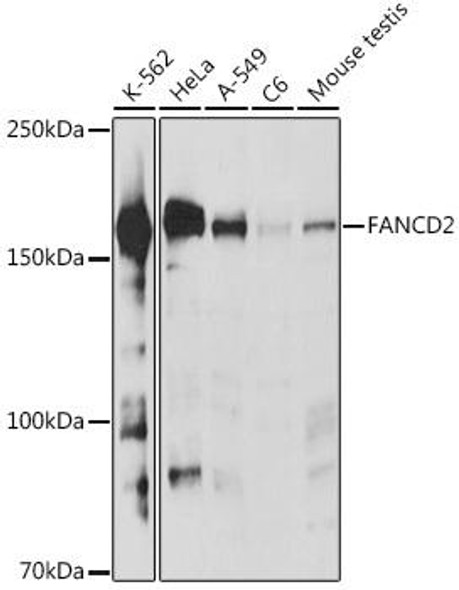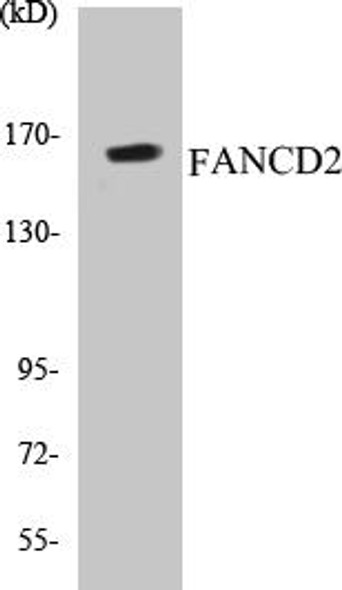Cell Cycle Antibodies 2
Anti-FANCD2 Antibody (CAB19692)
- SKU:
- CAB19692
- Product Type:
- Antibody
- Reactivity:
- Human
- Reactivity:
- Mouse
- Reactivity:
- Rat
- Host Species:
- Rabbit
- Isotype:
- IgG
- Research Area:
- Cell Cycle
Description
| Antibody Name: | Anti-FANCD2 Antibody |
| Antibody SKU: | CAB19692 |
| Antibody Size: | 20uL, 50uL, 100uL |
| Application: | WB |
| Reactivity: | Human, Mouse, Rat |
| Host Species: | Rabbit |
| Immunogen: | A synthesized peptide derived from human FANCD2. |
| Application: | WB |
| Recommended Dilution: | WB 1:500 - 1:2000 |
| Reactivity: | Human, Mouse, Rat |
| Positive Samples: | K-562, HeLa, A-549, C6, Mouse testis |
| Immunogen: | A synthesized peptide derived from human FANCD2. |
| Purification Method: | Affinity purification |
| Storage Buffer: | Store at -20°C. Avoid freeze / thaw cycles. Buffer: PBS with 0.02% sodium azide, 0.05% BSA, 50% glycerol, pH7.3. |
| Isotype: | IgG |
| Sequence: | Email for sequence |
| Gene ID: | 2177 |
| Uniprot: | Q9BXW9 |
| Cellular Location: | |
| Calculated MW: | 166kDa |
| Observed MW: | 166KDa |
| Synonyms: | FA4, FAD, FACD, FAD2, FA-D2, FANCD, FANCD2 |
| Background: | The Fanconi anemia complementation group (FANC) currently includes FANCA, FANCB, FANCC, FANCD1 (also called BRCA2), FANCD2, FANCE, FANCF, FANCG, FANCI, FANCJ (also called BRIP1), FANCL, FANCM and FANCN (also called PALB2). The previously defined group FANCH is the same as FANCA. Fanconi anemia is a genetically heterogeneous recessive disorder characterized by cytogenetic instability, hypersensitivity to DNA crosslinking agents, increased chromosomal breakage, and defective DNA repair. The members of the Fanconi anemia complementation group do not share sequence similarity; they are related by their assembly into a common nuclear protein complex. This gene encodes the protein for complementation group D2. This protein is monoubiquinated in response to DNA damage, resulting in its localization to nuclear foci with other proteins (BRCA1 AND BRCA2) involved in homology-directed DNA repair. Alternative splicing results in multiple transcript variants. [provided by RefSeq, Feb 2016] |
| UniProt Protein Function: | FANCD2: Required for maintenance of chromosomal stability. Promotes accurate and efficient pairing of homologs during meiosis. Involved in the repair of DNA double-strand breaks, both by homologous recombination and single-strand annealing. May participate in S phase and G2 phase checkpoint activation upon DNA damage. Plays a role in preventing breakage and loss of missegregating chromatin at the end of cell division, particularly after replication stress. Required for the targeting, or stabilization, of BLM to non-centromeric abnormal structures induced by replicative stress. Promotes BRCA2/FANCD1 loading onto damaged chromatin. May also be involved in B-cell immunoglobulin isotype switching. Interacts directly with FANCE and FANCI. Interacts with USP1 and MEN1. The ubiquitinated form specifically interacts with BRCA1 and BLM. Both the nonubiquitinated and the monoubiquitinated forms interact with BRCA2; this interaction is mediated by phosphorylated FANCG and the complex also includes XCCR3. The ubiquitinated form specifically interacts with MTMR15/FAN1 (via UBZ-type zinc finger), leading to recruit MTMR15/FAN1 to sites of DNA damage. Interacts with DCLRE1B/Apollo. Highly expressed in germinal center cells of the spleen, tonsil, and reactive lymph nodes, and in the proliferating basal layer of squamous epithelium of tonsil, esophagus, oropharynx, larynx and cervix. Expressed in cytotrophoblastic cells of the placenta and exocrine cells of the pancreas. Highly expressed in testis, where expression is restricted to maturing spermatocytes. 4 isoforms of the human protein are produced by alternative splicing. |
| UniProt Protein Details: | Protein type:DNA repair, damage Chromosomal Location of Human Ortholog: 3p26 Cellular Component: condensed chromosome; cytoplasm; nucleolus; nucleoplasm; nucleus Molecular Function:protein binding Biological Process: DNA repair; gamete generation; response to gamma radiation; synapsis Disease: Fanconi Anemia, Complementation Group D2; Tracheoesophageal Fistula With Or Without Esophageal Atresia |
| NCBI Summary: | The Fanconi anemia complementation group (FANC) currently includes FANCA, FANCB, FANCC, FANCD1 (also called BRCA2), FANCD2, FANCE, FANCF, FANCG, FANCI, FANCJ (also called BRIP1), FANCL, FANCM and FANCN (also called PALB2). The previously defined group FANCH is the same as FANCA. Fanconi anemia is a genetically heterogeneous recessive disorder characterized by cytogenetic instability, hypersensitivity to DNA crosslinking agents, increased chromosomal breakage, and defective DNA repair. The members of the Fanconi anemia complementation group do not share sequence similarity; they are related by their assembly into a common nuclear protein complex. This gene encodes the protein for complementation group D2. This protein is monoubiquinated in response to DNA damage, resulting in its localization to nuclear foci with other proteins (BRCA1 AND BRCA2) involved in homology-directed DNA repair. Alternative splicing results in multiple transcript variants. [provided by RefSeq, Feb 2016] |
| UniProt Code: | Q9BXW9 |
| NCBI GenInfo Identifier: | 727863575 |
| NCBI Gene ID: | 2177 |
| NCBI Accession: | Q9BXW9.2 |
| UniProt Secondary Accession: | Q9BXW9,Q2LA86, Q69YP9, Q6PJN7, Q9BQ06, Q9H9T9, |
| UniProt Related Accession: | Q9BXW9 |
| Molecular Weight: | 27,501 Da |
| NCBI Full Name: | Fanconi anemia group D2 protein |
| NCBI Synonym Full Names: | Fanconi anemia complementation group D2 |
| NCBI Official Symbol: | FANCD2 |
| NCBI Official Synonym Symbols: | FA4; FAD; FACD; FAD2; FA-D2; FANCD |
| NCBI Protein Information: | Fanconi anemia group D2 protein |
| UniProt Protein Name: | Fanconi anemia group D2 protein |
| Protein Family: | FANCD2 opposite strand protein |
| UniProt Gene Name: | FANCD2 |
| UniProt Entry Name: | FACD2_HUMAN |





![Anti-FANCD2 Antibody (CAB18055)[KO Validated] Anti-FANCD2 Antibody (CAB18055)[KO Validated]](https://cdn11.bigcommerce.com/s-rd6ounxcu2/images/stencil/590x590/products/55199/59942/anti-fancd2-antibody-cab18055ko-validated__19473__34956.1706529198.jpg?c=1)

